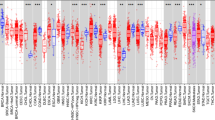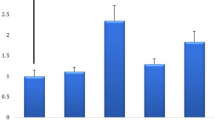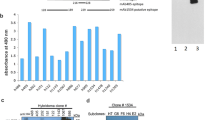Abstract
Purpose
The purpose of this study is to determine the association between the BIK/NBK gene expression and estrogen receptor alpha expression.
Materials and methods
We determined the association of BIK/NBK gene expression by real time quantitative reverse transcription polymerase chain reaction and estrogen receptor alpha expression by immunohistochemistry in samples of breast cancer tissue.
Results
We found a statistically significant correlation of BIK/NBK gene expression with the estrogen receptor alpha expression (ρ = 0.751, p = 0.004). For verify differences of BIK/NBK gene expression among ERα+ and ERα− breast cancer tissues, Mann–Whitney U test was performed, obtaining significant differences.
Conclusions
BIK/NBK gene expression may have important clinical implications and provide predictive, prognostic or therapeutic marker in breast cancer patients according to the estrogen receptor alpha expression.



Similar content being viewed by others
References
Benson JR, Jatoi I, Keisch M, Esteva FJ, Makris A, Jordan VC (2009) Early breast cancer. Lancet 373:1463–1479
Bryony S, Werb Z (2002) Stromal effects on mammary gland development and breast cancer. Science 296:1046–1049
Medina D (2005) Mammary developmental fate and breast cancer risk. Endocr Relat Cancer 12:483–495
Thiantanawat A, Long BJ, Brodie AM (2003) Signaling pathways of apoptosis by aromatase inhibitors and antiestrogens. Cancer Res 63:8037–8050
Ellis PA, Saccani-Jotti G, Clarke R et al (1997) Induction of apoptosis by tamoxifen and ICI 182780 in primary breast cancer. Int J Cancer 72:608–613
Kandouz M, Lombet A, Perrot JY et al (1999) Proapoptotic effects of antiestrogens, progestins and androgen in breast cancer cells. J Steroid Biochem Mol Biol 69:463–471
Banks E, Beral V, Bull D, Reeves G (2003) Breast cancer and hormone-replacement therapy in the million women study. Lancet 362:419–427
Rossouw JE, Anderson GL, Prentice RL et al (2002) Writing Group for the Women’s Health Initiative Investigators: risks and benefits of estrogen plus progestin in healthy postmenopausal women: principal results from the Women’s Health Initiative randomized controlled trial. JAMA 288:321–333
Early Breast Cancer Triallists’ Collaborative Group (1998) Tamoxifen for early breast cancer: an overview of the randomized trials. Lancet 351:1451–1467
Herold CI, Blackwell KL (2008) Aromatase inhibitors for breast cancer: proven efficacy across the spectrum of disease. Clin Breast Cancer 8:50–64
Wang TTY, Phang JM (1995) Effects of estrogen on apoptotic pathways in human breast cancer cell line MCF-7. Cancer Res 55:2487–2489
Leung LK, Do L, Wang TT (1998) Regulation of death promoter Bak expression by cell density and 17 beta-estradiol in MCF-7 cells. Cancer Lett 124:47–52
Evan G, Littlewood T (1998) A matter of life and cell death. Science 281:1317–1322
Dragovich T, Rudin CM, Thompson CB (1998) Signal transduction pathways that regulate cell survival and cell death. Oncogene 17:3207–3213
Hur J, Chesnes J, Coser KR et al (2004) The Bik BH3-only protein is induced in estrogen-starved and antiestrogen-exposed breast cancer cells and provokes apoptosis. Proc Natl Acad Sci USA 101:2351–2356
García N, Salamanca F, Astudillo-de la Vega H, Curiel-Quesada E, Alvarado I, Peñaloza R, Arenas D (2005) A molecular analysis by gene expression profiling reveals Bik/NBK overexpression in sporadic breast tumor samples of Mexican females. BMC Cancer 5:93
Schmittgen TD, Livak KJ (2008) Analyzing real-time PCR data by the comparative C(T) method. Nat Protocol 3:1101–1108
Cotran RS, Kumar V, Robbins SL, Schoen FJ (1994) Pathologic basis of disease book, 5th edn. W.B. Saunders Company, USA
Abba MC, Hu Y, Sun H et al (2005) Gene expression signature of estrogen receptor α status in breast cancer. BMC Genomics 6:37
Klinge CM (2001) Estrogen receptor interaction with estrogen response elements. Nucleic Acids Res 29:2905–2919
Nilsson S, Mäkelä S, Treuter E (2001) Mechanims of estrogen action. Physiol Rev 81:1535–1565
Pedram A, Razandi M, Aitkenhead M, Hughes CCW, Levin ER (2002) Integration of the non-genomic and genomic actions of estrogen. J Biol Chem 277:50768–50775
Coser KR, Chesnes J, Hur J, Ray S, Isselbacher KJ, Shioda T (2003) Global analysis of ligand sensitivity of estrogen inducible and suppressible genes in MCF7/BUS breast cancer cells by DNA microarray. Proc Natl Acad Sci USA 100:13994–13999
Bourdeau V, Deschenes J, Laperrière D, Aid M, White JH, Mader S (2008) Mechanisms of primary and secondary estrogen target gene regulation in breast cancer cells. Nucl Acids Res 36:76–93
Lewis-Wambi JS, Craig JV (2009) Estrogen regulation of apoptosis: how can one hormone stimulate and inhibit? Breast Cancer Res 11:206
Simstein R, Burow M, Parker A, Weldon C, Beckman B (2003) Apoptosis, chemoresistance, and breast cancer: insights from the MCF-7 cell model system. Exp Biol Med (Maywood) 228:995–1003
Burow ME, Weldon CB, Tang Y, McLachlan JA, Beckman BS (2001) Oestrogen-mediated suppression of tumour necrosis factor alpha-induced apoptosis in MCF-7 cells: subversion of Bcl-2 by anti-oestrogens. J Steroid Biochem Mol Biol 78:409–418
Pratt MAC, Bishop TE, White D, Yasvinski G, Ménard M, Niu MY, Clarke R (2003) Estrogen withdrawal-induced NF-κB activity and Bcl-3 expression in breast cancer cells: roles in growth and hormone independence. Mol Cell Biol 23:6887–6900
Zhang G-J, Kimijima I, Onda M et al (1999) Tamoxifen-induced apoptosis in breast cancer cells relates to down-regulation of bcl-2, but not bax and bcl-XL, without alteration of p53 protein levels. Clin Cancer Res 5:2971–2977
Kandouz M, Siromachkova M, Jacob D, Chretien-Marquet B, Therwath A, Gompel A (1996) Antagonism between estradiol and progestin on BCL-2 expression in breast-cancer cells. Int J Cancer 68:120–125
Teixeira C, Reed JC, Pratt MAC (1995) Estrogen promotes chemotherapeutic drug resistance by a mechanism involving Bcl-2 proto-oncogene expression in human breast cancer cells. Cancer Res 55:3902–3907
Zajchowski D, Sager R, Webster L (1993) Estrogen inhibits the growth of estrogen receptor-negative, but not estrogen receptor-positive, human mammary epithelial cells expressing a recombinant estrogen receptor. Cancer Res 53:5004–5011
Santen R, Jeng M-H, Wang J-P (2001) Adaptative hypersensitivity to estradiol: potential mechanism for secondary hormonal responses in breast cancer patients. J Steroid Biochem Mol Biol 79:115–125
Yue W, Berstein LM, Wang J-P (2001) The potential role of estrogen in aromatase regulation in the breast. J Steroid Biochem Mol Biol 79:157–164
Bertram JS (2000) The molecular biology of cancer. Mol Aspects Med 21:167–223
Adams J, Cory S (1998) The Bcl-2 protein family: arbiters of cell survival. Science 281:1322–1326
Holmgreen SP, Huang DCS, Adams JM, Cory S (1999) Survival activity of Bcl-2 homologs Bcl-w and A1 only partially correlates with their ability to bind pro-apoptotic family members. Cell Death Differ 6:525–532
Shimizu S, Tsujimoto Y (2000) Proapoptotic BH3-only Bcl-2 family members induce cytochrome c release, but not mitochondrial membrane potential loss, and do not directly modulate voltage-dependent anion channel activity. Proc Natl Acad Sci USA 97:577–582
Tsujimoto Y (2003) Cell death regulation by the Bcl-2 protein family in the mitochondria. J Cell Physiol 195:158–167
Brunell JK, Letai A (2009) Control of mitochondrial apoptosis by the Bcl-2 family. J Cell Sci 122:437–441
Verma S, Budarf ML, Emanuel BS, Chinnadurai G (2000) Structural analysis of the human pro-apoptotic gene Bik: chromosomal localization, genomic organization and localization of promoter sequences. Gene 254:157–162
Mathai JP, Germain M, Shore GC (2005) BH3-only BIK regulates BAX, BAK-dependent release of Ca2+ from endoplasmic reticulum stores and mitochondrial apoptosis during stress-induced cell death. J Biol Chem 280:23829–23836
Gillissen B, Essmann F, Graupner V et al (2003) Induction of cell death by the BH3-only Bcl-2 homolog Nbk/Bik is mediated by an entirely Bax-dependent mitochondrial pathway. EMBO J 22:3580–3590
Germain M, Mathai JP, McBride HM, Shore GC (2005) Endoplasmic reticulum BIK initiates DRP1-regulated remodelling of mitochondrial cristae during apoptosis. EMBO J 24:1546–1556
Rashmi R, Pillai SG, Vijayalingam S, Ryerse J, Chinnadurai G (2008) BH3-only protein BIK induces caspase-independent cell death with autophagic features in Bcl-2 null cells. Oncogene 27:1366–1375
Clarke R, Leonessa F, Welch JN, Skaar TC (2001) Cellular and molecular pharmacology of antiestrogen action and resistance. Pharmacol Rev 53:25–71
Fu Y, Li J, Lee AS (2007) GRP78/BiP inhibits endoplasmic reticulum BIK and protects human breast cancer cells against estrogen starvation-induced apoptosis. Cancer Res 67:3734–3740
Mitchell-Olds T, Knight CA (2002) Evolution. Chaperones as buffering agents? Science 296:2348–2349
Zhu H, Zhang L, Dong F et al (2005) Bik/NBK accumulation correlates with apoptosis-induction by bortezomib (PS-341, Velcade) and other proteasome inhibitors. Oncogene 24:4993–4999
Zhu H, Guo W, Zhang L et al (2005) Proteasome inhibitors-mediated TRAIL resensitization and Bik accumulation. Cancer Biol Ther 4:781–786
Ranganathan AC, Zhang L, Adam AP, Aguirre-Ghiso JA (2006) Functional coupling of p38-induced up-regulation of BiP and activation of RNA-dependent protein kinase-like endoplasmic reticulum kinase to drug resistance of dormant carcinoma cells. Cancer Res 66:1702–1711
Chinnadurai G, Vijayalingam S, Rashmi R (2009) BIK, the founding member of the BH3-only family proteins: mechanisms of cell death and role in cancer and pathogenic processes. Oncogene 27:s220–s229
Acknowledgments
This work was supported by Grants No. 2007-785-063 from FIS (Fondo de Investigación en Salud).
Conflict of interest
The authors declare that they have no competing interests.
Author information
Authors and Affiliations
Corresponding author
Rights and permissions
About this article
Cite this article
López-Muñoz, E., Hernández-Zarco, A., García-Hernández, N. et al. BIK/NBK gene as potential marker of prognostic and therapeutic target in breast cancer patients. Clin Transl Oncol 14, 586–591 (2012). https://doi.org/10.1007/s12094-012-0845-8
Received:
Accepted:
Published:
Issue Date:
DOI: https://doi.org/10.1007/s12094-012-0845-8




